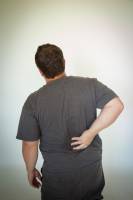PainRelief.com Interview
with:
Susan Murphy, Sc.D., O.T.R.
Associate Professor
Physical Medicine and Rehabilitation Department
Research Health Science Specialist
VA Ann Arbor Health Care System, GRECC
PainRelief.com: What is the
background for this study?
Response: Chronic low back pain is very common and affects
quality of life by reducing the ability to carry out needed and valued
activities. In addition, people with chronic low back pain tend to have other
symptoms like fatigue, sleep disturbances, and depression. Medications are
typically prescribed but have side effects, and in some cases, may increase the
risk of abuse and addiction. Non-pharmacological treatments are an important
part of chronic pain management and may reduce pain as well as other symptoms.
In this study, we examined the use of self-administered acupressure as a pain management strategy in people with chronic low back pain. Acupressure is a Traditional Chinese Medicine technique in which physical pressure is applied to specific points on the body. It is similar to acupuncture, but instead of needles, pressure is applied with a finger, thumb, or device. In previous studies, people with cancer-related or osteoarthritis pain who self-applied acupressure had reduced symptoms such as pain and fatigue.
PainRelief.com: What are the main findings?
Response: Our pilot randomized controlled trial involved 67
participants with chronic low back pain. They were randomized into one of three
groups – relaxing acupressure, stimulating acupressure, or usual care.
Participants in the acupressure groups were trained to apply pressure to
specific anatomical points on their body, and asked to complete daily treatment
sessions for 6 weeks. We found that people who performed stimulating
acupressure had improved pain and fatigue, and people who performed relaxing
acupressure had improved pain after 6 weeks compared to those in the usual care
group. No differences among the groups were found for sleep quality or
disability after 6 weeks. Participants performed an average of 85% of the daily
acupressure sessions and there were minimal adverse events. Adverse events,
such as skin breakdown, muscle spasm, and headache were attributed to applying
too much pressure and adjustments in application technique was done to avoid
future issues.
PainRelief.com: What should readers take away from your report?
Response: Self-administered acupressure shows some promising
effects on pain and fatigue in people with chronic low back pain. It is a low
cost and low risk symptom management strategy that people can adhere to.
PainRelief.com: What recommendations do you have for future research as
a result of this work?
Response: Because this was only a pilot study, larger studies
are needed to support the effectiveness of this treatment for people with
chronic low back pain.
Citation:
Susan
Lynn Murphy, Richard Edmund Harris, Nahid Roonizi Keshavarzi, Suzanna Maria
Zick, Self-Administered Acupressure for Chronic Low Back Pain: A Randomized
Controlled Pilot Trial, Pain Medicine, ,
pnz138, https://doi.org/10.1093/pm/pnz138
[wysija_form id=”3″]
[last-modified]
The information on PainRelief.com
is provided for educational purposes only, and is in no way intended to
diagnose, cure, or treat any medical or other condition. Always seek the advice
of your physician or other qualified health and ask your doctor any questions
you may have regarding a medical condition. In addition to all other
limitations and disclaimers in this agreement, service provider and its third
party providers disclaim any liability or loss in connection with the content
provided on this website.





 Dr. Frances MK Williams PhD
Dr. Frances MK Williams PhD